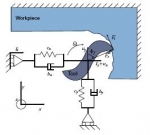Prediction and Control of Regenerative Chatter by Modelling and Analysis of the Milling Process
Abstract Category: Engineering
Course / Degree: Master of Technology
Institution / University: Indian Institute of Technology, Kharagpur, India
Published in: 2005
1. Modelling
A model is necessary to generate accurate Stability Lobe Diagrams offline. Moreover, during the process, it is possible that the shape of a SLD changes. Therefore, it is necessary to monitor the process online and keep the cut chatter-free by using a model-based controller. A schematic representation of the milling process is shown in Fig. 1.
The chip thickness is the sum of the static chip thickness, dictated by the machine, and the dynamic displacement of the current tooth minus the dynamic displacement of the previous tooth at time t= Tau. This introduces a delay term in the model. A block diagram of the model is shown in Fig. 3. The resulting model is a non-linear, non-autonomous delay differential equation. In order to generate the SLD using common methods [1,2], both the timedependent and non-linear term have to be eliminated.
2. Stability Analysis
Assuming the chatter frequency as omega c , the system characteristic equation can be obtained as: Eqn. 8
By introducing the transfer function between the cutting force and cutter tip displacement, the critical depth of cut, alim , and the free spindle speed, Omega , can be derived as a function of omega c.
To address the flexibility of the cutting tool,we constructed the stability diagram and compared with the modal analysis results. The dominated mode in [1] was selected to use.
Assume a 8-teeth end milling cutter with 19mm diameter, 241mm in length, in a half immersion-up milling of aluminum workpiece. Cutting constants are assumed as Kt =1500 MPa , Kr =0.3 and damping ratio is 0.1. The end-milling cutter has one natural frequency (348Hz), which is the same as the dominated frequency in [1].
For the assumed end-milling cutter, we obtained two sets of stability lobes. One is obtained by applying the Timoshenko cantilever beam model and the other considering an Euler-Bernoulli cantilever beam for the cutter, based on the method described by J. W. Sutherland [3]. After calculating the modal mass and stiffness for the cutter, we apply Altintas’ stability analysis method [1] around the dominated mode (348Hz). The stability lobes are shown in Fig 2. It is obvious that the Timoshenko cantilever beam modal results in more conservative results.
3. Results
The ”Cutting” and ”Machine” block are dependent on the spindle speed [4].
The SLD is predicted well for low spindle speeds.
Thesis Keywords/Search Tags:
Self Excited Vibration, Stability, Modelling, Prediction
This Thesis Abstract may be cited as follows:
No user preference. Please use the standard reference methodology.
Submission Details: Thesis Abstract submitted by Debraj Sarangi from India on 09-Mar-2006 15:30.
Abstract has been viewed 5792 times (since 7 Mar 2010).
Debraj Sarangi Contact Details: Email: sarangi_00@mech.iitkgp.ernet.in
Disclaimer
Great care has been taken to ensure that this information is correct, however ThesisAbstracts.com cannot accept responsibility for the contents of this Thesis abstract titled "Prediction and Control of Regenerative Chatter by Modelling and Analysis of the Milling Process". This abstract has been submitted by Debraj Sarangi on 09-Mar-2006 15:30. You may report a problem using the contact form.
© Copyright 2003 - 2025 of ThesisAbstracts.com and respective owners.




